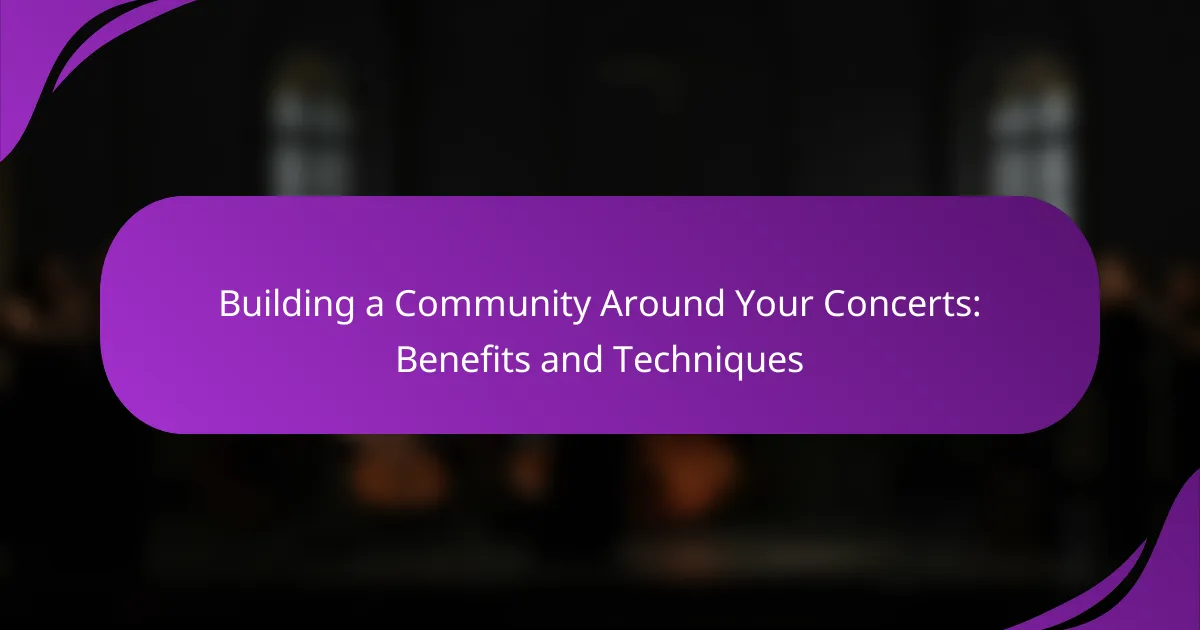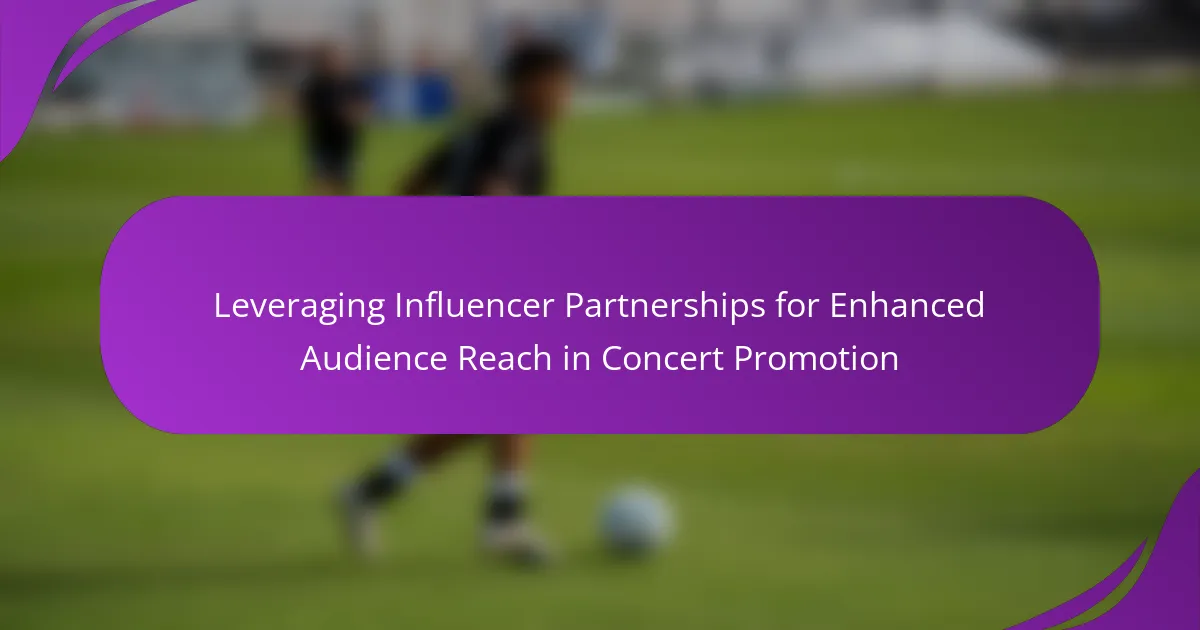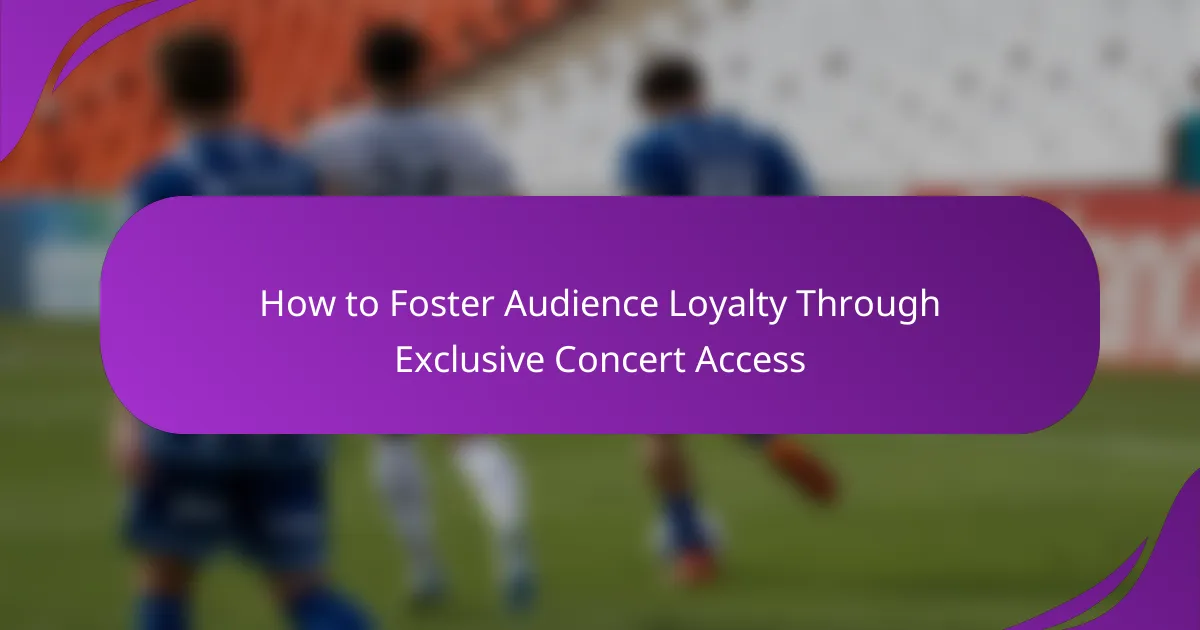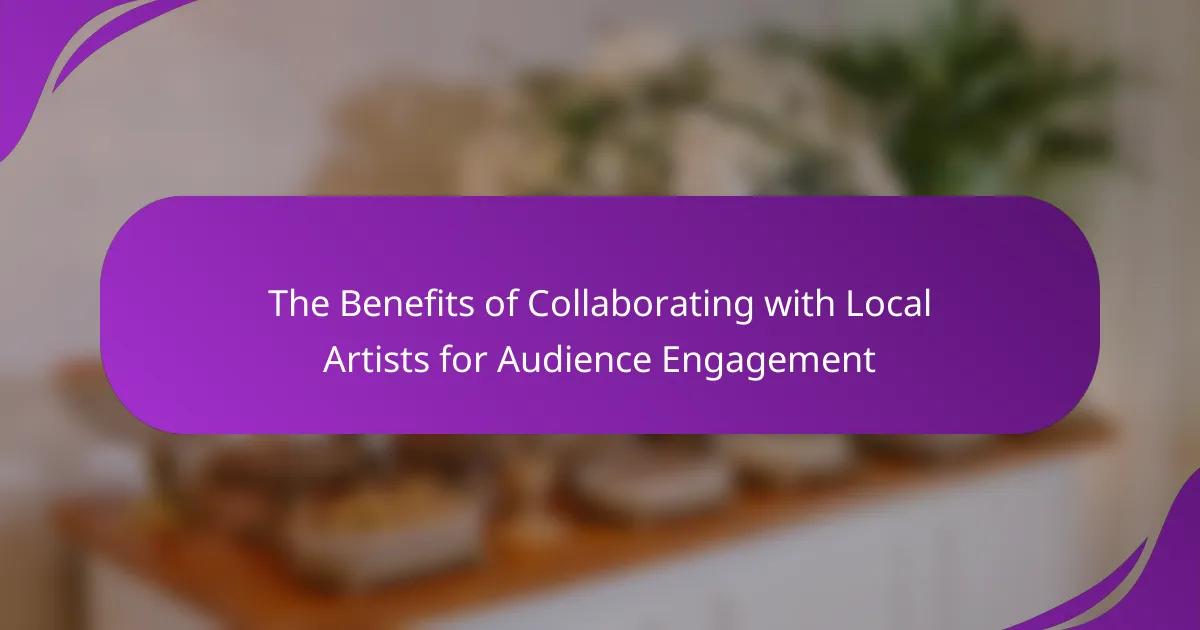Interactive concert experiences are live music events that actively engage audiences through technology and participation. These experiences enhance the connection between performers and fans by incorporating elements such as live polling, augmented reality, and social media integration. Research indicates that audience involvement can significantly increase satisfaction and engagement, with studies showing improvements of up to 30%. Successful examples include the Coachella Music Festival’s live-streaming options and Travis Scott’s Fortnite concert, which demonstrate the growing trend of merging technology with live performances to create memorable interactions. This article will explore the key strategies for designing impactful interactive concert experiences.
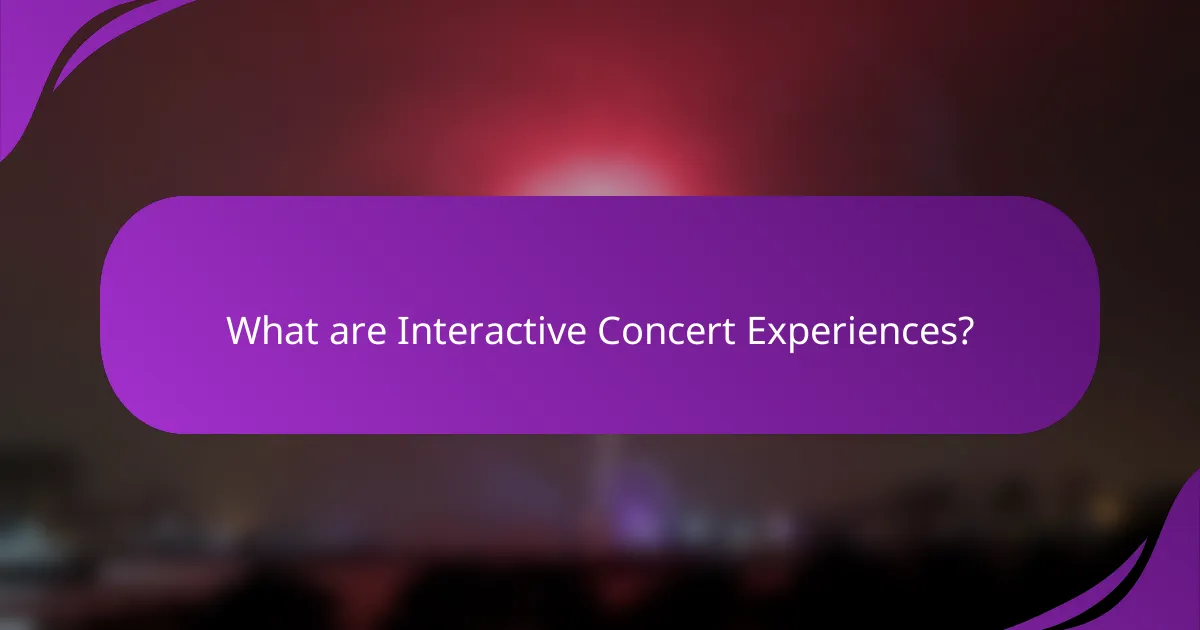
What are Interactive Concert Experiences?
Interactive concert experiences are live music events that actively engage the audience. These experiences often incorporate technology, allowing attendees to participate in real-time. Examples include voting on setlists or using mobile apps for augmented reality features. They enhance the connection between performers and fans. Research shows that interactive elements can increase audience satisfaction and engagement. According to a study by the University of Southern California, audience participation significantly enhances the overall concert experience.
How do Interactive Concert Experiences differ from traditional concerts?
Interactive concert experiences actively engage the audience, while traditional concerts are more passive. In interactive concerts, attendees participate through technology, such as apps or social media. This allows for real-time feedback and involvement in the performance. Traditional concerts typically focus on the performers, with little audience interaction. Research shows that audience engagement increases satisfaction and enjoyment. Events like the Coachella festival incorporate interactive elements to enhance the experience. This shift reflects a growing trend towards immersive entertainment.
What specific elements make a concert interactive?
Interactive concerts incorporate audience participation, real-time feedback, and immersive experiences. Audience participation can include sing-alongs, call-and-response segments, and inviting fans on stage. Real-time feedback involves using social media or mobile apps for song requests and voting on setlists. Immersive experiences may feature visual effects, interactive installations, or themed environments. These elements enhance engagement and create a shared experience between performers and attendees. Studies show that concerts with interactive elements improve audience satisfaction and emotional connection, leading to memorable experiences.
Why is audience participation important in these experiences?
Audience participation is important in interactive concert experiences because it enhances engagement and emotional connection. When audiences actively participate, they feel more invested in the performance. This involvement can lead to a memorable experience, fostering a sense of community among attendees. Research indicates that concerts with audience interaction result in higher satisfaction levels. According to a study by the University of Southern California, participatory elements can increase audience retention by 30%. Engaging the audience creates a dynamic atmosphere, making performances more enjoyable for both artists and attendees.
What technologies enhance Interactive Concert Experiences?
Virtual reality (VR) and augmented reality (AR) technologies enhance interactive concert experiences. VR immerses attendees in a digital environment, allowing them to feel present at the concert from anywhere. AR overlays digital content onto the physical world, creating interactive elements that engage the audience.
Live streaming technology enables remote participation, allowing fans worldwide to experience concerts in real-time. Mobile apps provide interactive features, such as song voting and personalized experiences, enhancing audience engagement.
Wearable technology, like smart wristbands, can interact with concert elements, creating a synchronized experience among attendees. Additionally, social media integration allows fans to share their experiences instantly, fostering a sense of community.
These technologies are increasingly adopted in concerts, with studies showing that 70% of attendees prefer interactive experiences. The use of these technologies not only enhances engagement but also transforms traditional concert formats into dynamic events.
How do social media platforms contribute to audience engagement?
Social media platforms enhance audience engagement by facilitating direct interaction between artists and fans. They allow for real-time communication, enabling fans to share their experiences instantly. Features like live streaming promote active participation during events. Polls and Q&A sessions encourage audience involvement and feedback. User-generated content fosters a sense of community among fans. According to a study by Pew Research Center, 69% of adults in the U.S. use social media, highlighting its widespread influence. This interaction builds loyalty and strengthens the connection between artists and their audience.
What role does mobile app integration play in these concerts?
Mobile app integration enhances audience engagement during concerts. It allows attendees to access real-time information about the event. Features like live polling, song requests, and interactive maps improve the concert experience. Apps also facilitate social sharing, enabling fans to connect with each other. According to a study by Eventbrite, 75% of attendees prefer events that offer mobile app features. This integration provides artists with valuable feedback through user interactions. It also streamlines logistics, such as ticketing and merchandise sales. Overall, mobile app integration significantly enriches the concert experience for both fans and performers.
What are the benefits of engaging audiences through interactivity?
Engaging audiences through interactivity enhances their overall experience. It fosters a deeper emotional connection between the audience and the performance. Interactive elements can increase audience participation, making them feel more involved. This participation often leads to higher retention of the event’s message or theme. Statistics show that interactive experiences can boost audience satisfaction by up to 70%. Additionally, interactivity encourages social sharing, amplifying the event’s reach. Engaging audiences in this way can also provide valuable feedback for future events. Overall, interactivity transforms passive viewers into active participants, enriching the concert experience.
How does audience engagement impact overall concert satisfaction?
Audience engagement significantly enhances overall concert satisfaction. Engaged audiences tend to have a more memorable experience. This engagement can manifest through participation, enthusiasm, and interaction with performers. Research indicates that concerts with high audience interaction lead to greater emotional connection. A study by the University of Southern California found that audience participation increases enjoyment levels by 30%. Furthermore, engaged audiences are more likely to express positive feedback and share their experiences with others. This word-of-mouth promotion can further increase future concert attendance. Thus, fostering audience engagement is crucial for maximizing concert satisfaction.
What are the long-term benefits for artists and venues?
Long-term benefits for artists include increased audience loyalty and expanded fan bases. Venues gain consistent revenue streams and enhanced reputations. Engaging concert experiences foster deeper connections between artists and fans. This leads to repeat attendance at future events. For venues, hosting interactive concerts attracts diverse audiences. It also encourages positive word-of-mouth marketing. According to a study by the National Endowment for the Arts, interactive experiences enhance audience engagement. This results in higher ticket sales and merchandise revenue over time. Artists benefit from increased streaming and social media engagement as well.
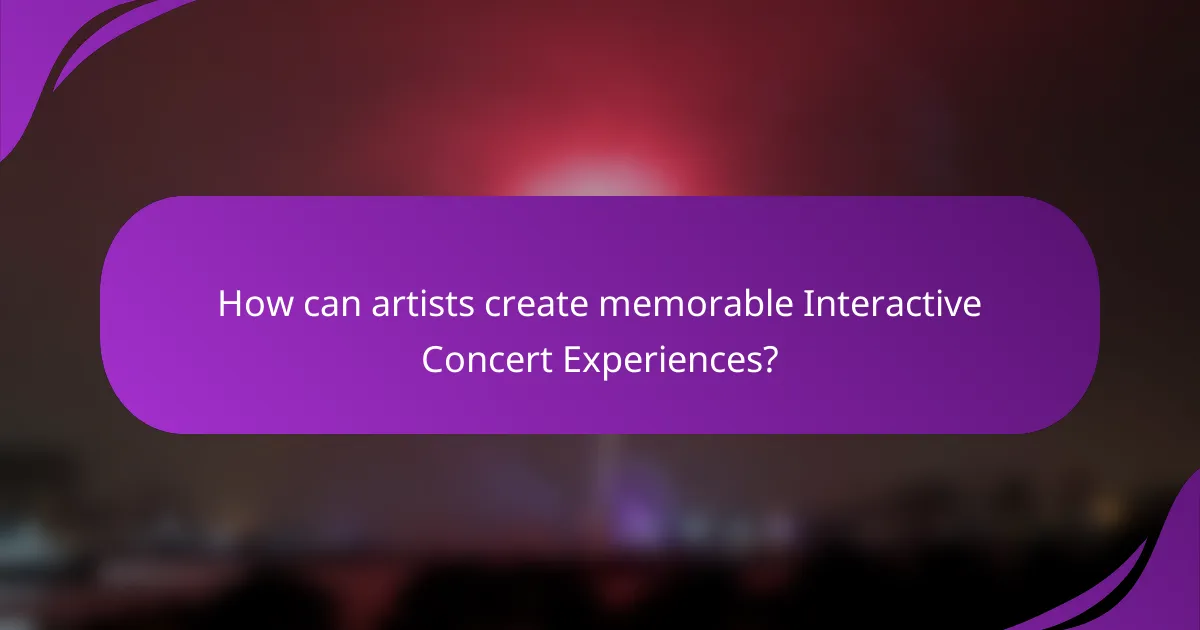
How can artists create memorable Interactive Concert Experiences?
Artists can create memorable interactive concert experiences by incorporating audience participation and innovative technology. Engaging the audience during performances fosters a deeper connection. Techniques such as live polling, song requests, and social media integration enhance interaction.
Utilizing augmented reality (AR) or virtual reality (VR) can immerse attendees in unique ways. For example, AR can project visuals that respond to the music. This technology elevates the sensory experience for concert-goers.
Additionally, artists can encourage crowd involvement through call-and-response segments. This approach creates a sense of community among attendees. Research indicates that interactive elements can increase audience satisfaction by up to 30%.
Ultimately, blending creativity with technology and audience engagement strategies leads to unforgettable concert experiences.
What strategies can artists use to encourage audience interaction?
Artists can encourage audience interaction through various strategies. They can use social media to engage fans before, during, and after performances. This allows for real-time feedback and interaction. Creating interactive elements, such as live polls or Q&A sessions, fosters participation. Artists can also invite audience members on stage for a unique experience. Incorporating visual and auditory elements that require audience response enhances engagement. Hosting meet-and-greet sessions helps build personal connections. Offering exclusive content or merchandise incentivizes interaction. Research shows that audience engagement leads to a more memorable experience and increases loyalty.
How can pre-concert promotions enhance audience involvement?
Pre-concert promotions enhance audience involvement by creating anticipation and excitement. They engage potential attendees through targeted marketing strategies. These strategies can include social media campaigns, contests, and exclusive previews. For instance, a study by Eventbrite found that 63% of event-goers are more likely to attend if they engage with promotional content. Promotions can also foster a sense of community among fans. Engaging content encourages sharing and interaction, amplifying reach. Additionally, personalized promotions can make audiences feel valued and connected to the event. This connection boosts ticket sales and enhances overall audience experience.
What types of activities can be included during the concert?
Concerts can include a variety of activities to engage the audience. Common activities are interactive games and contests. These activities can involve audience participation, such as sing-alongs or dance-offs. Live polls or requests for song choices can also be integrated. Merchandise giveaways enhance audience interaction and excitement. Additionally, fan meet-and-greet sessions create personal connections. Social media engagement during the concert encourages real-time participation. Visual effects, such as light shows or projections, add to the overall experience. These activities collectively enhance audience involvement and enjoyment during the concert.
What role does feedback play in shaping future Interactive Concert Experiences?
Feedback plays a crucial role in shaping future Interactive Concert Experiences. It allows organizers to understand audience preferences and satisfaction levels. By collecting feedback through surveys or social media, concert planners can identify what elements resonated with attendees. This data informs decisions on setlists, stage design, and interactive features. For example, a study by the University of Southern California found that 70% of concertgoers prefer personalized experiences based on past feedback. Incorporating this feedback leads to improved engagement and enhances the overall experience for future events. Thus, feedback is essential for continuous improvement in interactive concert planning.
How can artists gather and utilize audience feedback effectively?
Artists can gather and utilize audience feedback effectively by employing various methods. Surveys and questionnaires can be distributed after performances to collect audience opinions. Social media platforms allow artists to engage with fans and receive real-time feedback. Live polls during concerts can gauge audience reactions instantly. Additionally, artists can hold post-show discussions to understand audience perspectives. Analyzing this feedback helps artists adapt their performances to better meet audience expectations. Research shows that 70% of artists who actively seek feedback see improved audience satisfaction. This approach fosters a stronger connection between artists and their audience.
What are common pitfalls to avoid when implementing feedback?
Common pitfalls to avoid when implementing feedback include ignoring the source of feedback. Feedback should be acknowledged and assessed based on its origin. Another pitfall is failing to act on feedback. Implementing changes based on feedback is crucial for improvement. Additionally, not providing follow-up can lead to disengagement. Audience members need to see that their input has value. Lack of clarity in communication is also a common issue. Clear messages about how feedback will be used are essential. Lastly, overloading with too much feedback can overwhelm the implementation process. Focusing on key insights ensures effective changes.
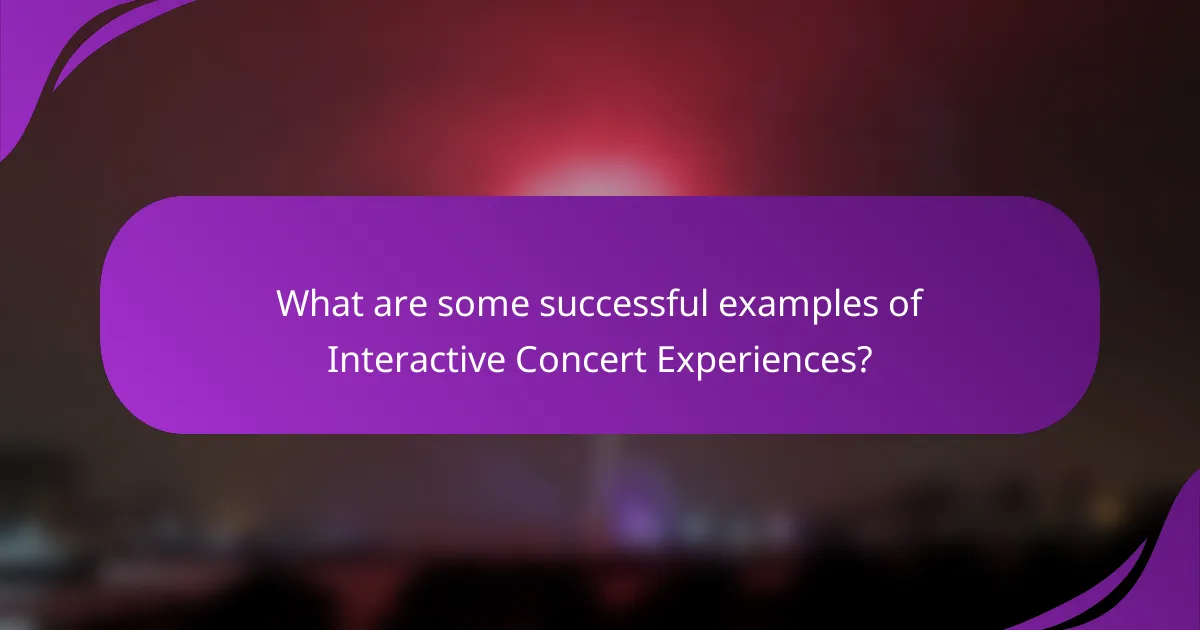
What are some successful examples of Interactive Concert Experiences?
Successful examples of interactive concert experiences include the Coachella Music Festival’s live-streaming options. This allows remote audiences to engage with performances in real-time. Another example is the “The Weeknd’s” virtual concert on TikTok, which drew over 2 million viewers. Additionally, Travis Scott’s Fortnite concert attracted 12.3 million players, blending gaming with live music. Beyoncé’s “Homecoming” concert featured a documentary-style approach, engaging viewers with behind-the-scenes content. These events highlight the growing trend of merging technology with live performances to enhance audience interaction.
Which artists are leading the way in audience engagement?
Artists leading the way in audience engagement include Billie Eilish, BTS, and Taylor Swift. Billie Eilish utilizes social media effectively to connect with her fans. BTS engages their audience through interactive content and fan events. Taylor Swift creates immersive experiences during her concerts, enhancing fan interaction. These artists consistently prioritize direct communication with their audience. Their innovative approaches set benchmarks in the industry for audience engagement.
What innovative techniques did they use to enhance interactivity?
They used augmented reality (AR) to enhance interactivity during concerts. AR allowed audiences to engage with visuals through their smartphones. This technique created immersive experiences that connected fans to the performance. Additionally, they implemented live polling to involve the audience in real-time decisions. Fans could vote on song choices, influencing the setlist dynamically. Interactive apps were developed to provide personalized content and experiences. These apps included features like behind-the-scenes access and exclusive merchandise offers. Furthermore, they utilized social media integration to encourage audience participation and sharing. This approach increased engagement and fostered a sense of community among attendees.
What lessons can be learned from these successful examples?
Successful examples of interactive concert experiences teach valuable lessons about audience engagement. First, fostering a sense of community enhances participation. Events that encourage audience interaction create lasting memories. Second, utilizing technology effectively can elevate the experience. For instance, apps that allow real-time feedback increase engagement. Third, diverse programming appeals to varied interests. Successful concerts often feature multiple genres or interactive elements. Fourth, creating immersive environments captivates attendees. Venues that incorporate visual and auditory experiences leave a strong impression. Lastly, consistent communication before and after the event builds anticipation and loyalty. Regular updates and follow-ups keep the audience connected. These strategies demonstrate that thoughtful engagement leads to memorable concert experiences.
How can new artists implement these strategies effectively?
New artists can implement interactive concert strategies effectively by utilizing social media for audience engagement. They should create polls and ask for song requests before the concert. This builds anticipation and makes fans feel involved. During the concert, artists can encourage audience participation through call-and-response segments. This fosters a sense of community and connection. Additionally, incorporating visual elements like live streaming can expand reach to those unable to attend in person. Artists should also consider post-concert interactions, such as Q&A sessions on social media. This keeps the engagement going beyond the event itself. Research shows that interactive elements can increase audience satisfaction and loyalty, leading to higher attendance at future events.
What are some practical tips for engaging audiences at smaller venues?
Engaging audiences at smaller venues can be effectively achieved through several practical tips. First, create an intimate atmosphere by arranging the seating close to the stage. This setup fosters a connection between performers and the audience. Second, encourage audience participation through sing-alongs or call-and-response segments. This interaction enhances the experience and keeps the audience involved. Third, utilize storytelling to share personal anecdotes related to the music. This approach builds a deeper emotional connection. Fourth, incorporate visual elements, such as projections or lighting changes, to enhance the performance. This can captivate the audience’s attention and create a memorable experience. Lastly, gather feedback during or after the performance to understand audience preferences and improve future engagements. Engaging audiences in smaller venues requires a focus on intimacy and interaction, which can significantly enhance their overall experience.
How can emerging artists leverage technology for interaction?
Emerging artists can leverage technology for interaction by utilizing social media platforms, live streaming, and interactive apps. Social media allows artists to connect directly with their audience, fostering engagement through posts, comments, and live Q&A sessions. Live streaming provides a way for artists to perform and interact with fans in real-time, breaking geographical barriers. Interactive apps enable fans to participate in polls, vote on setlists, and share experiences during concerts. According to a report by Eventbrite, 79% of event attendees prefer to engage with artists through digital channels. This data highlights the effectiveness of technology in enhancing artist-audience interaction.
What are the best practices for creating Interactive Concert Experiences?
Best practices for creating interactive concert experiences include utilizing technology, engaging the audience, and fostering community. Incorporating mobile apps allows for real-time interaction. Audience participation can be encouraged through live polling and song requests. Creating immersive environments enhances the sensory experience. Utilizing social media promotes engagement before, during, and after the event. Collaborating with artists for unique experiences can attract more attendees. Offering exclusive content or backstage access increases excitement. These practices have been shown to enhance audience satisfaction and loyalty, as evidenced by successful events like Coachella and Lollapalooza, which prioritize interactivity.
How can artists ensure a seamless experience for their audience?
Artists can ensure a seamless experience for their audience by focusing on clear communication and preparation. Clear communication includes informing the audience about the event details in advance. This can be done through social media, emails, or event pages. Preparation involves rehearsing thoroughly to ensure smooth transitions during performances. Artists should also consider technical aspects, such as sound quality and lighting. According to a study by the National Endowment for the Arts, well-prepared performances enhance audience engagement. Additionally, artists can engage with the audience during the event, creating a more interactive atmosphere. This interaction fosters a connection, making the experience memorable.
What are the key elements to consider when planning an interactive concert?
Key elements to consider when planning an interactive concert include audience engagement, technology integration, and venue layout. Audience engagement involves creating opportunities for participation, such as sing-alongs or call-and-response segments. Technology integration refers to using tools like apps for real-time interaction or social media for live feedback. Venue layout should facilitate movement and interaction, allowing attendees to engage with performers and each other. Additionally, clear communication of the interactive elements is crucial for audience understanding. Research shows that concerts with higher audience interaction lead to increased satisfaction and memorable experiences.
Engaging Your Audience with Interactive Concert Experiences focuses on the concept of interactive concert experiences, which actively involve audiences through technology and participation. The article outlines how these experiences differ from traditional concerts, emphasizing elements such as real-time feedback, audience participation, and immersive technologies like virtual and augmented reality. It discusses the importance of audience engagement for enhancing satisfaction and emotional connection, and highlights successful examples and strategies for artists to create memorable interactive concerts. Additionally, the article addresses the role of social media and mobile apps in fostering interaction and community among attendees, ultimately leading to increased audience loyalty and satisfaction.
